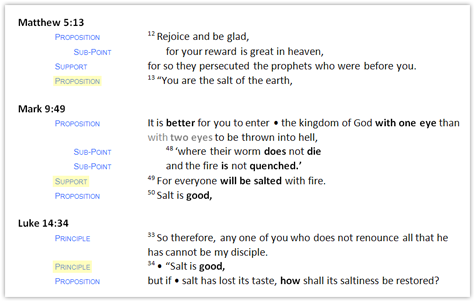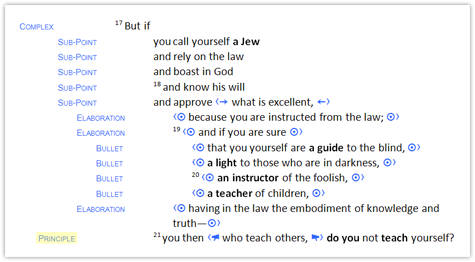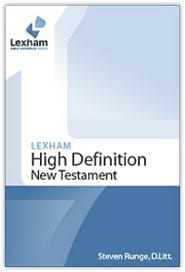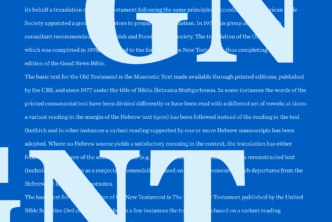Today’s guest post is from Dr. Steve Runge, a scholar-in-residence at Logos Bible Software, whose work focuses on the discourse grammar of Hebrew and Greek.
I am currently teaching a class on the parables of Jesus at my church. We are looking at the parables that occur in more than one gospel and taking note of how they are used in each. Along the way we have come across differences in wording, begging that question: ‘So what?’
This week we looked at the ‘salt’ passages, found in Matthew 5:13; Mark 9:49-50; and Luke 14:34-35. We noticed that there are some significant differences in how this parable is related to the preceding context in the different gospels. There are two new resources called the Lexham High Definition New Testament and the Lexham Discourse Greek New Testament that provide some really helpful insight into issues like this. These resources annotate where the NT writers used various devices to get our attention, emphasize things, build suspense, etc.
Another important contribution of these resources is a description in the left column that tells you what each line of the text is doing. This analysis is informed by things like the Greek conjunction used, the morphology of the verb, and the role that it plays in the larger context. We were using the Lexham High Definition New Testament in class, and it was really easy to point out how the different gospel writers wanted to connect the salt parable to the preceding context, since it was plainly spelled out in the left column. ‘Proposition means that there are no specific instructions about how to relate what follows to what precedes. ‘Support’ indicates that what follows in intended to strengthen or support what precedes, but does not advance the story or the argument. ‘Principle’ indicates that what follows is a summary or conclusion drawn from what precedes, often providing the big idea for the section that follows. Take a look at the highlighted descriptions in the left column.

In Matthew’s gospel, the saying follows right on the heals of the Beatitudes. In Greek there is no specific conjunction that tells the reader how to connect it; it is just the next saying.
In Mark the section just before describes how it is better to cast off a part of you that causes you to sin than to keep it and risk being thrown into hell. The saying about the salt is connected to this with the Greek conjunction γάρ (for). This instructs us to understand what follow as supporting or strengthening what precedes, rather than introducing a new point. In other words, Mark has signaled with γάρ that the saying about the salt is connected to what precedes, supporting and strengthening it.
If you look at Luke 14:34, you will see that the verse begins with a bullet. In the ESV English-Greek Reverse Interlinear New Testament, you can see that the bullet stands in the place of the Greek conjunction οὖν (therefore). This word signals that what follows is a principle or summary drawn from what precedes. In other words, it either summarizes what precede, or introduces a new principle that is drawn from what precedes. The preceding section in Luke describes counting the cost of discipleship, illustrated by the consideration that should be given before building a tower or going to war against a superior force. This means that Luke wanted us to read the saying about the salt as drawing from and building upon what precedes.
In each of these gospels, the saying about the salt losing its saltiness warns us about the hazard of losing the distinctive quality that makes us who we are, illustrated by salt losing its saltiness. In Matthew Jesus has just taught that when we encounter persecution for pursuing righteousness, we should rejoice and be glad. In such circumstances, one might be tempted to water down their faith, or put their light under a basket (cf. 5:15). The reference to salt adds to this same point by asking the question: ‘What good is salt if it loses its saltiness?’ If we water-down or hide our faith, then what’s the point?
In Mark, the same point is made by the reference to salt. If there is some part of us that is causing us to sin, that might destine us for hell, is it really worth hanging on to? The reference to salt presents the same issue from a different angle. The salting with fire suggests a refining process. But if this process does not produce real, salty salt, then what’s the point? The Christian life is not about hanging on to what Jesus died to free us from, but about being the salt and light that he redeemed us to be.
In Luke, Jesus has just given a summary principle in v. 33 drawn from the illustrations of building a tower and going to war: “So therefore, any one of you who does not renounce all that he has cannot be my disciple” (ESV). The saying about the salt is building upon this point, providing a practical illustration of what happens when someone follows without renouncing all: he or she is salt that is not salty. If the salt is no longer salty, then what’s the point?
This is just a one example of the kind of help that the left column information of the Lexham High Definition New Testament and the Lexham Discourse Greek New Testament can provide. It can really pay dividends in helping you understand the really hairy passages that use very complex grammar, unpacking it one bit at a time. Check out Romans 2:17 in the HDNT:

Paul wants to set up a very complex state of affairs, one which can get confusing in a hurry if you are just reading it in a continuous paragraph. His main point is this: Do you not teach yourself? The ‘complex’ marker tells you that the line that is only indented one place is the main idea of the complex clause. In this case, the main thought is the ‘principle’ line. The rest of the parts are indented and labeled to help you understand what role each plays, and to let you easily find the main idea.
We are nearing completion on this project, which means two things: it will be shipping soon, and the price will be going up when it is removed from Pre-Publication. Take warning; buy soon if you haven’t already!
If you missed them, be sure to check out Steve’s previous posts.
- Who Cares About Participles? I Do!
- Making of the Lexham High Definition New Testament
- Stylistic Variation or Intentional Shaping? A Look at Characterization in John 11
- Waiting for the Next Shoe to Drop, Part 1
- Waiting for the Next Shoe to Drop, Part 2
- Talking about What I Am Talking About
- Paying Attention to ‘This’ and ‘That’





